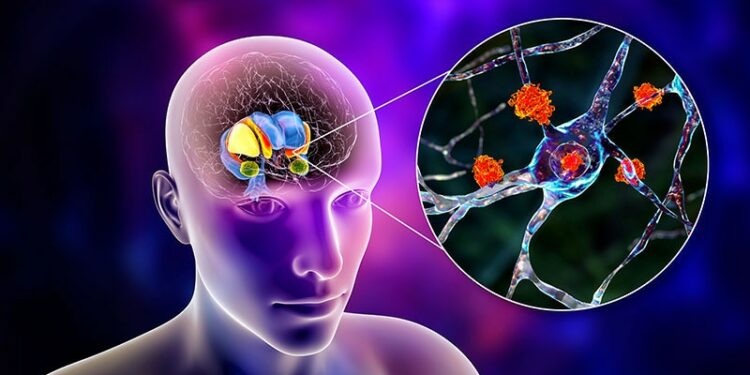[ad_1]
Subtle signs of neurodegeneration can be detected in blood, cerebrospinal fluid (CSF), and through neuroimaging, up to two decades before motor symptoms in Huntington’s disease (HD) present, new research showed.
Investigators believe these early biomarkers could pave the way for novel interventions that could improve outcomes for individuals at risk for HD.

“Decades before the onset of motor symptoms, we discovered that the rate of somatic cytosine-adenine-guanine (CAG) repeat expansion is predictive of the earliest loss of striatal neurons in humans,” study investigator Sarah Tabrizi, PhD, director of Huntington’s Disease Center, University College London in London, England, told Medscape Medical News.
“These sensitive biomarker measures will help us design prevention trials, which has never been done before,” she added.
The findings were published online on January 17 in Nature Medicine.
Searching for Biomarkers
HD is an autosomal dominant genetic disorder affecting five to ten in 100,000 people and caused by a mutation of the huntingtin (HTT) gene, which results in extended CAG trinucleotide repeats.
In individuals with HD, the sequence tends to lengthen continually in a process known as somatic CAG expansion. Typically, those with HD will have ≥ 40 CAG repeats on the HTT gene.
By the time motor symptoms appear, there is already substantial striatal neurodegeneration. As a result, investigators have long sought to establish biomarkers earlier in the disease process to advance prevention and treatment efforts.
They have also worked to better understand why the disease strikes in the prime of life, with motor symptoms in people with HD typically emerging between the ages of 30 years and 50 years.
To find the answers, Tabrizi and colleagues analyzed data from the HD Young Adult Study. Tabrizi recruited 73 HD gene expanded (HDGE) participants about 23 years before clinical motor diagnosis and compared them with 81 participants without HD but matched on age, sex, and education scores.
Study participants underwent a series of cognitive, clinical, and neuropsychiatric tests at baseline and again at 4.5 years follow-up. They also underwent brain imaging, as well as blood and CSF testing at both timepoints.
At baseline, 81% of participants with HD were in stage 0 of the disease as determined by the HD Integrated Staging System (HD-ISS), indicating striatal volumes were equal to that of the general population. Of this sample, 17% were in stage 1, characterized by the presence of pathogenic biomarkers.
At follow-up, 4.5 years later, 63% of the HD sample was in stage 0 and 35% had progressed to stage 1.
Early Signs of Neurodegeneration
When investigators compared the HD group with the control group at the follow-up visit there was no significant decline in clinical, neuropsychiatric, or cognitive function compared with the control group.
However, CSF markers showed early signs of neurodegeneration in the HDGE group, with elevated neurofilament light (NfL) protein — an indicator of neuroaxonal damage — which increased more rapidly between baseline and follow-up compared with control group (P = .01).
Between baseline and follow-up, the researchers found a significant longitudinal reduction in levels of proenkephalin (PENK), a neuropeptide marker for striatal medium spiny neurons in the CSF of participants with HDGE, but not in control participants (P = .00044).
A comparison of MRI scans between the two groups revealed significantly greater rates of atrophy in the putamen (P = .0000000004) and caudate (P = .00000000011) in HDGE participants than control participants. There were also significant group differences with reductions in gray matter (P = .0075), white matter (P = .014), and whole brain (P = .00071), with associated ventricular expansion (P = .000039).
“Neuroimaging results suggest that across HD-ISS stages 0 and 1, there are already elevated rates of brain atrophy accompanied by subtle microstructural white matter changes,” the authors wrote.
Blood sample DNA analysis revealed significant longitudinal increases in the somatic expansion ratio (SER) over 4.5 years in the HDGE group (P = .00000002) and with a pronounced acceleration influenced by CAG repeat length (P = .00003).
Predictors of Change
Even after controlling for age and CAG, baseline NfL and CSF PENK were predictors of atrophy in all brain regions over time. data showed.
After controlling for age and CAG, the rate of change in the caudate and putamen was most strongly associated with change in CSF NfL (P = .0003 and P = .00022, respectively) and CSF PENK (P = .002 and P = .0001, respectively).
The longitudinal increase in SER was a significant predictor of the rate of subsequent caudate volume change before (P = .01) and after age-by-CAG correction (P = .03). It was also a significant predictor of the rate of subsequent putamen volume change before (P = .02) and after (P = .049) age-by-CAG correction.
The finding of early disease biomarkers dovetail with results from a postmortem study recently published in Cell demonstrating silent, decades-long expansion of somatic CAG repeats on HTT, resulting in neurodegeneration that leads to symptoms of HD.
The research also revealed that DNA tracts with ≥ 40 CAG repeats expand over time until they are hundreds of CAGs long. Once CAGs reach ≥ 150, symptoms become apparent.
Previously reported data combined with these new findings “really point towards somatic CAG repeat expansion driving the neurodegeneration in Huntington’s disease,” Tabrizi said. “These findings are important because they tell us that somatic CAG repeat expansion is driving the disease and the earliest loss in the striatum, where the disease is clearly beginning.”
At the invitation of the US Food and Drug Administration and the Critical Path Institute, Tabrizi traveled to Washington DC in 2024 to discuss prevention trials in the very early stages of HD. “The plan is to prevent downstream disease,” she said.
‘Window of Opportunity’

Commenting on the research for Medscape Medical News, Erin Furr Stimming, MD, professor of neurology and director of the Huntington’s Disease Society of America Center of Excellence at UTHealth Houston, Houston, said, “the study supports new therapeutic targets aimed at decreasing or suppressing somatic CAG expansion and advances the understanding of the pathogenesis of HD.”
Furr Stimming, who was not part of the study, noted that most data on somatic CAG expansion have come from postmortem studies, so to find early indicators from living participants provides a potential window of opportunity for intervention with disease-modifying therapies, once available.
Furthermore, she said, data supporting the association between elevated levels of NfL and new data on reduced levels of PENK and neurodegeneration years before motor symptoms begin supports Furr Stimming’s clinical experience.
“Despite being able to genetically test people for HD, clinical diagnosis has typically been based on motor symptoms, with the most obvious sign being chorea,” she said.
However, before significant motor symptoms appear, there is typically a period where there may be subtle cognitive, motor, or psychiatric symptoms in the patient with HD, she added.
For instance, people with HD may struggle at work as they gradually lose focus, attention, and motivation. They may also have problems in relationships because they are prone to irritability or outbursts.
Over time, these problems become significant enough to impact functional independence.
“There have been proposed revised diagnostic criteria published with continued efforts underway to optimize HD diagnostic criteria, as it is just as important to consider the neuropsychiatric and cognitive symptoms as it is the motor symptoms,” which can also negatively affect quality of life and independence, said Furr Stimming.
This study was funded by the Wellcome Trust, the CHDI Foundation, the UK Dementia Research Institute, and UK Medical Research Council. Furr Stimming reported being on an advisory board for PTC Therapeutics, Wave Life Science, and Latus Bio.
[ad_2]
Source link : https://www.medscape.com/viewarticle/early-signs-huntingtons-detectable-decades-before-symptoms-2025a10001xe?src=rss
Author :
Publish date : 2025-01-27 07:41:22
Copyright for syndicated content belongs to the linked Source.














